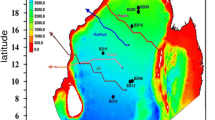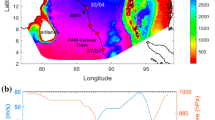Abstract
From the simulation of storm surges resulting from Typhoons 7203 and 8509 in the Bohai Sea, Yellow Sea and East China Sea, water level data at tide stations are assimilated into a two-dimensional storm surge model, to study the spatially varying drag coefficient (DC) by employing the adjoint method. In this study, the DC at some grid points is uniformly selected as the independent DC, while the DC at other grid points is obtained through linear interpolation of the independent DC. The DC at independent points is optimized by employing the adjoint assimilation method, and global optimization is achieved by optimizing the independent DC. To demonstrate the method’s performance, three comparative experiments are carried out. In the first experiment, the DC is treated as a constant. In the second and third experiments, the DC is derived using an empirical formula. Comparing the experimental results, it is found that the simulation accuracy for both Typhoons 7203 and 8509 increases greatly when optimizing the independent DC. However, the number of independent points makes no great difference to the precision of simulation. Moreover, the DC inverted from Typhoons 7203 and 8509 differs in some sea areas because of the different typhoon tracks. However, the spatial distribution of the inverted DC, for both Typhoons 7203 and 8509, demonstrates a clear effect of the DC on the storm surge modeling near the coastal areas where the DC is highest or lowest.
Similar content being viewed by others
References
Bajo M, Umgiesser G. 2010. Storm surge forecast through a combination of dynamic and neural network models. Ocean Modelling, 33: 1–9.
Cressman G P. 1959. An operational objective analysis system. Monthly Weather Review, 87: 367–374.
Gönnert G. 1999. The analysis of storm surge climate change along the German coast during the 20th century. Quaternary International, 56: 115–121.
He Y J, Lu X Q, Qiu Z F, Zhao J P. 2004. Shallow water tidal constituents in the Bohai Sea and the Yellow Sea from a numerical adjoint model with TOPEX/POSEIDON altimeter data. Continental Shelf Research, 24: 1 521–1 529.
Hubbert G D, Leslie L M, Manton M J. 1990. A storm surge model for Australian region. Quarterly Journal of the Royal Meteorological Society, 116: 1 005–1 020.
Hubbert G D, Holland G J, Leslie L M, Manton M J. 1991. A real-time system for forecasting tropical cyclone storm surges. Weather and Forecasting, 6: 86–97.
Jelesnianski C P. 1965. A numerical calculation of storm tides induced by a tropical storm impinging on a continental shelf. Monthly Weather Review, 93(6): 343–358.
Jelesnianski C P. 1972. SPLASH (Special Program to List the Amplitudes of Surges from Hurricanes) I. Landfall Storms. NOAA Technical Memorandum NWS TDL-46. National Weather Service Systems Development Office, Silver Spring, Maryland. 56p.
Jelesnianski C P, Chen J, Shaffer W A. 1992. SLOSH (Sea, Lake, and Overland Surges from Hurricanes). NOAA Technical Report NWS 48. National Weather Service, Silver Spring, Maryland. 71p.
Jones J E, Davies A M. 1998. Storm surge computations for the Irish Sea using a three-dimensional numerical model including wave-current interaction. Continental Shelf Research, 18: 201–251.
Kawahara M, Hirano H, Tsubota K, Inagaki K. 1982. Selective lumping finite element method for shallow water flow. International Journal for Numerical Methods in Engineering, 2: 89–112.
Konishi T, Kinosita T, Takahashi H. 1985. Storm surges in estuaries. Papers of the 17th Joint Meeting US-Japan Panel on Wind and Seismic Effects. p.735–749.
Konishi T, Kamihira E, Segawa T. 1986. Storm surges and secondary undulations due to the Typhoon 8506. Tenki, 33: 263–270. (in Japanese)
Konishi T, Tsuji Y. 1995. Analyses of storm surges in the western part of the Seto Inland Sea of Japan caused by Typhoon 9119. Continental Shelf Research, 15(14): 1 795–1 823.
Lionello P, Sanna A, Elvini E, Mufato R. 2006. A data assimilation procedure for operational prediction of storm surge in the northern Adriatic Sea. Continental Shelf Research, 26: 539–553.
Lü X Q, Zhang J C. 2006. Numerical study on spatially varying bottom friction coefficient of a 2D tidal model with adjoint method. Continental Shelf Research, 26: 1 905–1 923.
Lü X Q, Wu Z K, Gu Y, Tian J W. 2004. Study on the adjoint method in data assimilation and the related problems. Applied Mathematics and Mechanics, 25(6): 636–646.
Murakami K, Morikawa M, Horie T. 1985. Numerical simulations of storm surges by alternating direction implicit method. Technical Not, Port and Harbour Research Institute, 529, 35p.
Moon I J, Kwon J I, Lee J C, Shim J S, Kang S K, Oh I S, Kwon S J. 2009. Effect of the surface wind stress parameterization on the storm surge modeling. Ocean Modelling, 29: 115–127.
Peng S Q, Xie L, Pietrafesa L J. 2007. Correcting the errors in the initial conditions and wind stress in storm surge simulation using an adjoint optimal technique. Ocean Modelling, 18: 175–193.
Roy G D. 1995. Estimation of expected maximum possible water level along the Meghna Estuary using a tide and surge interaction model. Environment International, 21(5): 671–677.
Shen J, Wang H, Sisson M, Gong W P. 2006. Storm tide simulation in the Chesapeake Bay using an unstructured grid model. Estuarine, Coastal and Shelf Science, 68: 1–16.
Shi F Y, Sun W X, Wei G S. 1997. A WDM method on a generalized curvilinear grid for calculation of storm surge flooding. Applied Ocean Research, 19: 275–282.
Smith S D. 1980. Wind stress and heat flux over the ocean in gale force winds. Journal of Physical Oceanography, 10: 709–726.
Sztobryn M. 2003. Forecast of storm surge by means of artificial neural network. Journal of Sea Research, 49: 317–322.
Wu J. 1982. Wind-stress coefficients over sea surface from breeze to hurricane. Journal of Geophysical Research, 87: 9 704–9 706.
Wang X Q, Qian C C, Wang W. 2001. Test of influence of Wind Drag Coefficient on Typhoon Storm Surges Simulations. Journal of Ocean University of Qingdao, 31(5): 640–646. (in Chinese)
Yin B S, Xu Z H, Huang Y, Lin X. 2009. Simulating a typhoon storm surge in the East Sea of China using a coupled model. Progress in Natural Science, 19: 65–71.
Zampato L, Umgiesser G, Zecchetto S. 2007. Sea level forecasting in Venice through high resolution meteorological fields. Estuarine, Coastal and Shelf Science, 75: 223–235.
Zhang A J, Parker B B, Wei E. 2002. Assimilation of water level data into a coastal hydrodynamic model by an adjoint optimal technique. Continental Shelf Research, 22: 1 909–1 934.
Zhang A J, Wei E, Parker B B. 2003. Optimal estimation of tidal open boundary conditions using predicted tides and adjoint data assimilation technique. Continental Shelf Research, 23: 1 055–1 070.
Author information
Authors and Affiliations
Corresponding author
Additional information
Supported by the State Ministry of Science and Technology of China (Nos. 2007AA09Z118, 2008AA09A402), the National Natural Science Foundation of China (No. 41076006), and the Ministry of Education’s 111 Project (No. B07036)
Rights and permissions
About this article
Cite this article
Fan, L., Liu, M., Chen, H. et al. Numerical study on the spatially varying drag coefficient in simulation of storm surges employing the adjoint method. Chin. J. Ocean. Limnol. 29, 702–717 (2011). https://doi.org/10.1007/s00343-011-0160-1
Received:
Accepted:
Published:
Issue Date:
DOI: https://doi.org/10.1007/s00343-011-0160-1




